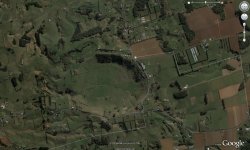Hi
This might sound like a dumb question, but if you have what you suspect to be a large crator, where would be the best place to find any reminants of a metorite. I am thinking the middle but the more i have read the edges seem to produce better results. I dont have a good understanding of how the metorite would desindergrate after impact. I am thinking anything in the middle would be pretty deep.
Can anyone share some light on this or offer some good advice. I am happy to PM anyone some cordinates of a site that i am looking at.
I have measured the photo below, its diameter is approx 1.1km across all around. I am guessing from memory but the floor of this impression would be approx 60-100metres deep.
cheers Sasnz
This might sound like a dumb question, but if you have what you suspect to be a large crator, where would be the best place to find any reminants of a metorite. I am thinking the middle but the more i have read the edges seem to produce better results. I dont have a good understanding of how the metorite would desindergrate after impact. I am thinking anything in the middle would be pretty deep.
Can anyone share some light on this or offer some good advice. I am happy to PM anyone some cordinates of a site that i am looking at.
I have measured the photo below, its diameter is approx 1.1km across all around. I am guessing from memory but the floor of this impression would be approx 60-100metres deep.
cheers Sasnz






